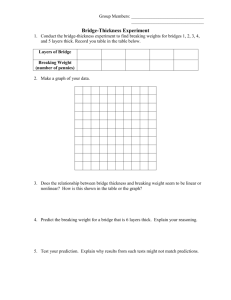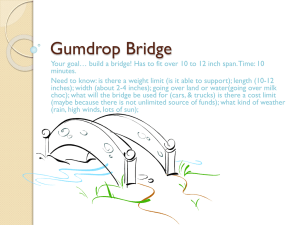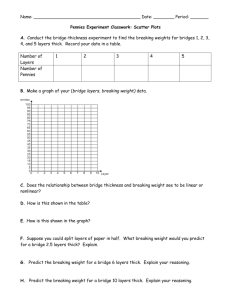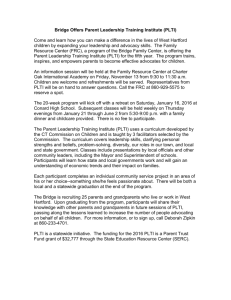Unit 1
advertisement
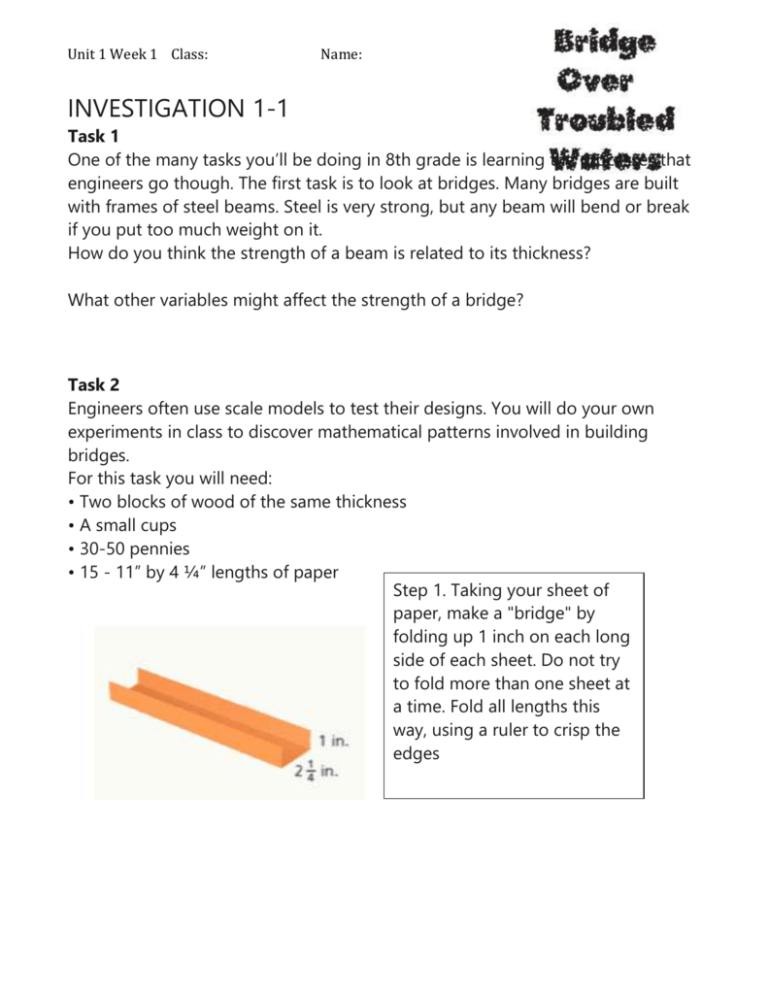
Unit 1 Week 1 Class: Name: INVESTIGATION 1-1 Task 1 One of the many tasks you’ll be doing in 8th grade is learning the processes that engineers go though. The first task is to look at bridges. Many bridges are built with frames of steel beams. Steel is very strong, but any beam will bend or break if you put too much weight on it. How do you think the strength of a beam is related to its thickness? What other variables might affect the strength of a bridge? Task 2 Engineers often use scale models to test their designs. You will do your own experiments in class to discover mathematical patterns involved in building bridges. For this task you will need: • Two blocks of wood of the same thickness • A small cups • 30-50 pennies • 15 - 11” by 4 ¼” lengths of paper Step 1. Taking your sheet of paper, make a "bridge" by folding up 1 inch on each long side of each sheet. Do not try to fold more than one sheet at a time. Fold all lengths this way, using a ruler to crisp the edges Task 3 Unit 1 Week 1 Class: Name: Task 4 Predict the breaking weight for a bridge 6 layers thick. Explain your reasoning. Task 5 Suppose you could split layers of paper in half. What breaking weight would you predict for a bridge 2.5 layers thick? Explain. Unit 1 Week 1 Class: Name: Explanation: 2) Suppose it is possible to use half-layers of construction paper. What breaking weight would you predict for a bridge 3.5 layers thick? Explain. 3) Predict the breaking weight for a construction-paper bridge of 8 layers. Explain how you made your prediction. Unit 1 Week 1 Class: Name: INVESTIGATION 1-2 Task 1 In the last investigation, you tested the strength of some paper bridges. You found that bridges with more layers are stronger than bridges with fewer layers. 1) How do you think the length and strength of a bridge are related? 2.) Are longer bridges stronger or weaker than shorter bridges? Why do you think so? Task 2 Today we will do an experiment to find out how the length and strength of a bridge are related. Instructions: For this task you will need: 1.) Fold the paper strips to make bridges as • Two blocks of wood or books shown. of the same thickness • A small cup • About 30-50 pennies • 4 ¼” wide paper strips with lengths 4, 6, 8, 9, and 11 inches 2.) Start with the 4-inch bridge. Suspend the bridge between the two blocks as you did before. The bridge should overlap each block by 1 inch. Place the paper cup in the center of the bridge. 3.) Put pennies into the cup, one at a time until the bridge collapses. Record the number of pennies you added to the cup. As in the first experiment, this number is the breaking weight of the bridge. Repeat this process for the other lengths of bridge Task 3 Unit 1 Week 1 Class: Name: Now, describe the relationship between bridge length and breaking weight. How is that relationship shown by patterns in your table and graph? Use your data to predict the breaking weights for bridges of lengths 3, 5, 10, and 12 inches. Explain how you made your predictions. Compare your data from this experiment to the data from the experiment on bridges with different numbers of layers (yesterday’s experiment). How is the relationship between the number of layers in a bridge and its breaking weight similar to the relationship between bridge length and breaking weight? How is it different? Unit 1 Week 1 Class: Name: Unit 1 Week 1 Class: Name: Step 2. Start with one of the paper strips. Suspend the bridge between the blocks of wood. The bridge should overlap each block by l inch on the ends. Place the cup in the center of the bridge. Step 3. Put pennies into the cup, one at a time, until the bridge collapses. We will define collapse in this experiment as when the bridge begins to have a bend that causes the paper to crease or fold over. Record the number of pennies you added to the cup. We will call this number the breaking weight of the bridge. Step 4. After you’ve recorded the information, take the old bridge and place it aside. Now put two new strips of paper together to make a bridge with twice as many layers. Find the breaking weight for this bridge. Step 5. Repeat this experiment to find the breaking weights of bridges made from three, four, and five strips of paper and complete the table.
